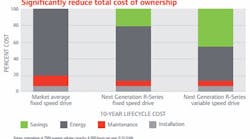Compressor innovation has parallels in the computer industry. For 50 years, Moore’s Law has driven advances in computer processing power and efficiency. Now, experts say, the pace of chip improvement is slowing down. What does that mean? How will our computers and smartphones keep getting more powerful if progress in chip efficiency hits a ceiling?
The answer lies in adjacent technologies, such as cloud computing and artificial intelligence. When inventors start looking outside their wheelhouse, the possibilities are infinite.
[sidebar id="2"]
Compressor technology has been around for more than 360 years, and in that time, we’ve seen tremendous advances in power and efficiency. We went from air billows to the highly sophisticated compressor technologies plants use around the world today. After three centuries of product innovation, progress becomes incremental, but breakthroughs still happen. Some breakthroughs occur in compressor equipment, while others occur in adjacent technologies that will take compression technologies and services to new levels of performance and efficiency.
True improvements in compressors require complex engineering feats, but sophisticated modeling technology can make them happen. One of the reasons improvements in rotary screw compressors, for example, are challenging is that a change to one factor affects another. Changing the pressure ratio, for instance, can increase internal air leakage, rotor speed, exhaust temperature, and wear on rotors and bearings. But in challenging computational fluid dynamics (CFD) modeling, convex and concave rotor profiles can be redesigned to create better airflow while maintaining reliability.
New motor technology also increases efficiency and performance. Adding variable-speed drive (VSD) options to the compressor reduces energy use at partial load by 35% by keeping the compressor running at the proper speed for the load demand, avoiding energy loss with modulating or on-off operation.
Ultimately, these savings translate to a lower total cost of ownership over the lifecycle of the compressor equipment.
Graphical images are based on Ingersoll Rand data studies.
While modeling and motor technologies have led to equipment improvements, some of the most exciting developments in compression technologies go beyond the compressor itself. For example, one exciting area of progress is in controls. We’ll discuss that example and more in more detail in future blog posts. The latest controls allow precise operation, remote diagnostics, and operation and integration with mobile devices.
Of course, in the era of Big Data, technologies for data collection, software, and analytics are also driving the future of compression technologies. Today, we’re able to collect and apply large amounts of data from a plant’s entire compressed air system to target problems and predict how changes will affect system efficiency. We can even run scenario-based analyses with “what if” simulations to identify potential solutions for energy consumption, plant performance, and cost. This gives plant owners and managers the ability to make smart investments and reduce lifecycle costs of their compressed air system. That’s innovation at its best.
